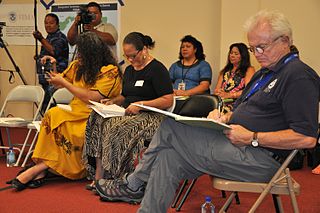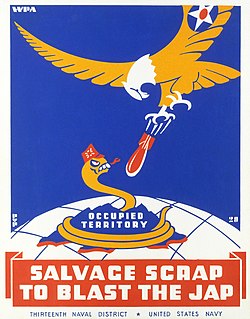
Public relations (PR) is the practice of managing and disseminating information from an individual or an organization to the public in order to affect their public perception. Public relations (PR) and publicity differ in that PR is controlled internally, whereas publicity is not controlled and contributed by external parties. Public relations may include an organization or individual gaining exposure to their audiences using topics of public interest and news items that do not require direct payment. The exposure mostly is media-based. This differentiates it from advertising as a form of marketing communications. Public relations aims to create or obtain coverage for clients for free, also known as earned media, rather than paying for marketing or advertising also known as paid media. But in the early 21st century, advertising is also a part of broader PR activities.
Disinformation is a subset of propaganda and is defined as false information that is spread deliberately to deceive people. It is sometimes confused with misinformation, which is false information but is not deliberate.
Corporate propaganda refers to propagandist claims made by a corporation, for the purpose of manipulating market opinion with regard to that corporation, and its activities.

Media manipulation is a series of related techniques in which partisans create an image or argument that favours their particular interests. Such tactics may include the use of logical fallacies, manipulation, outright deception (disinformation), rhetorical and propaganda techniques, and often involve the suppression of information or points of view by crowding them out, by inducing other people or groups of people to stop listening to certain arguments, or by simply diverting attention elsewhere. In Propaganda: The Formation of Men's Attitudes, Jacques Ellul writes that public opinion can only express itself through channels which are provided by the mass media of communication – without which there could be no propaganda. It is used within public relations, propaganda, marketing, etc. While the objective for each context is quite different, the broad techniques are often similar.
The following outline is provided as an overview of and topical guide to public relations:
A video news release (VNR) is a video segment made to look like a news report, but is instead created by a PR firm, advertising agency, marketing firm, corporation, government agency, or non-profit organization. They are provided to television newsrooms to shape public opinion, promote commercial products and services, publicize individuals, or support other interests. News producers may air VNRs, in whole or in part, at their discretion or incorporate them into news reports if they contain information appropriate to a story or of interest to viewers.

The Advertising Council, commonly known as the Ad Council, is an American nonprofit organization that produces, distributes, and promotes public service announcements on behalf of various sponsors, including nonprofit organizations, non-governmental organizations and agencies of the United States government.
Journalistic ethics and standards comprise principles of ethics and good practice applicable to journalists. This subset of media ethics is known as journalism's professional "code of ethics" and the "canons of journalism". The basic codes and canons commonly appear in statements by professional journalism associations and individual print, broadcast, and online news organizations.

Ogilvy is a New York City-based British advertising, marketing, and public relations agency. It was founded in 1850 by Edmund Mather as a London-based agency. In 1964, the firm became known as Ogilvy & Mather after merging with a New York City agency that was founded in 1948 by David Ogilvy.
Media ethics is the subdivision dealing with the specific ethical principles and standards of media, including broadcast media, film, theatre, the arts, print media and the internet. The field covers many varied and highly controversial topics, ranging from war journalism to Benetton ad campaigns.

Robert William Jensen is a former professor of journalism from the University of Texas at Austin. From 1992 to 2018 he taught graduate and undergraduate courses in media law, ethics, and politics.
Charlotte Beers is an American businesswoman and former Under Secretary of State.

Propaganda in the United States is spread by both government and media entities. Propaganda is carefully curated information, ideas, or rumors deliberately spread, usually to preserve the self-interest of a nation. It is used in advertising, radio, newspaper, posters, books, television and other media. Propagandists may provide either factual or non-factual information to their audiences, often emphasizing positive features and downplaying negative ones, or vice versa, in order to shape wide scale public opinion or influence behavioral changes.
Guy Aoki is a Japanese-American civil rights activist. He is the leader of the Media Action Network for Asian Americans (MANAA), which he co-founded in 1992. He is also a contributing columnist for the Rafu Shimpo, and debates publicly on Asian American issues.
The Nakdi Report is a document outlining the ethical guidelines of Israel's broadcasting industry.

Propaganda is information that is not impartial and used primarily to influence an audience and further an agenda, often by presenting facts selectively to encourage a particular synthesis, or using loaded messages to produce an emotional rather than a rational response to the information presented. The term propaganda has acquired a strongly negative connotation by association with its most manipulative and jingoistic examples.
Since the end of the 20th century, propaganda has evolved significantly. Today's propaganda is characterised by psych-ops and disinformation, whereas a few decades ago it was dominated by posters and simple films.
Fake news websites are Internet websites that deliberately publish fake news—hoaxes, propaganda, and disinformation purporting to be real news—often using social media to drive web traffic and amplify their effect. Unlike news satire, fake news websites deliberately seek to be perceived as legitimate and taken at face value, often for financial or political gain. Such sites have promoted political falsehoods in India, Germany, Indonesia and the Philippines, Sweden, Mexico, Myanmar, and the United States. Many sites originate in, or are promoted by, Russia, North Macedonia, Romania, and the United States.

Propaganda is a form of persuasion that is often used in media to further some sort of agenda, such as a personal, political, or business agenda, by evoking an emotional or obligable response from the audience. It includes the deliberate sharing of realities, views, and philosophies intended to alter behavior and stimulate people to act.
Disinformation attacks are the intentional dissemination of false information, with an end goal of misleading, confusing, or manipulating an audience. Disinformation attacks may be executed by state or non-state actors to influence domestic or foreign populations. These attacks are commonly employed to reshape attitudes and beliefs, drive a particular agenda, or elicit certain actions out of a target audience.








